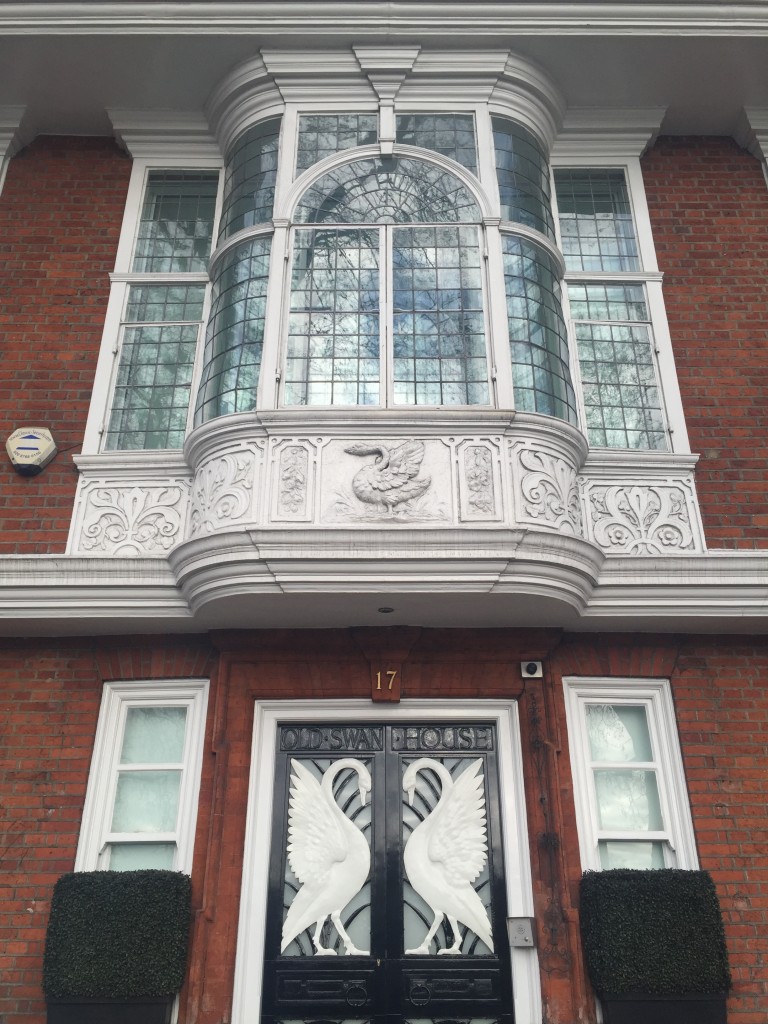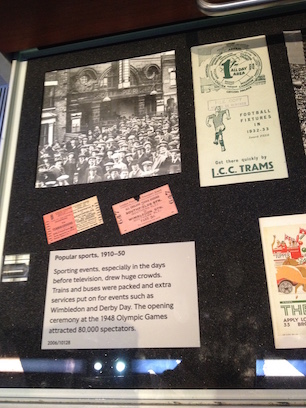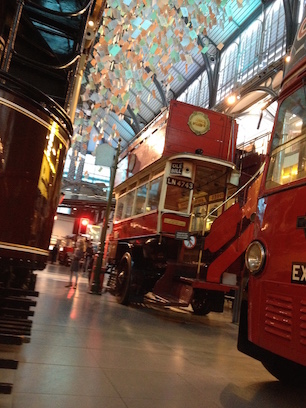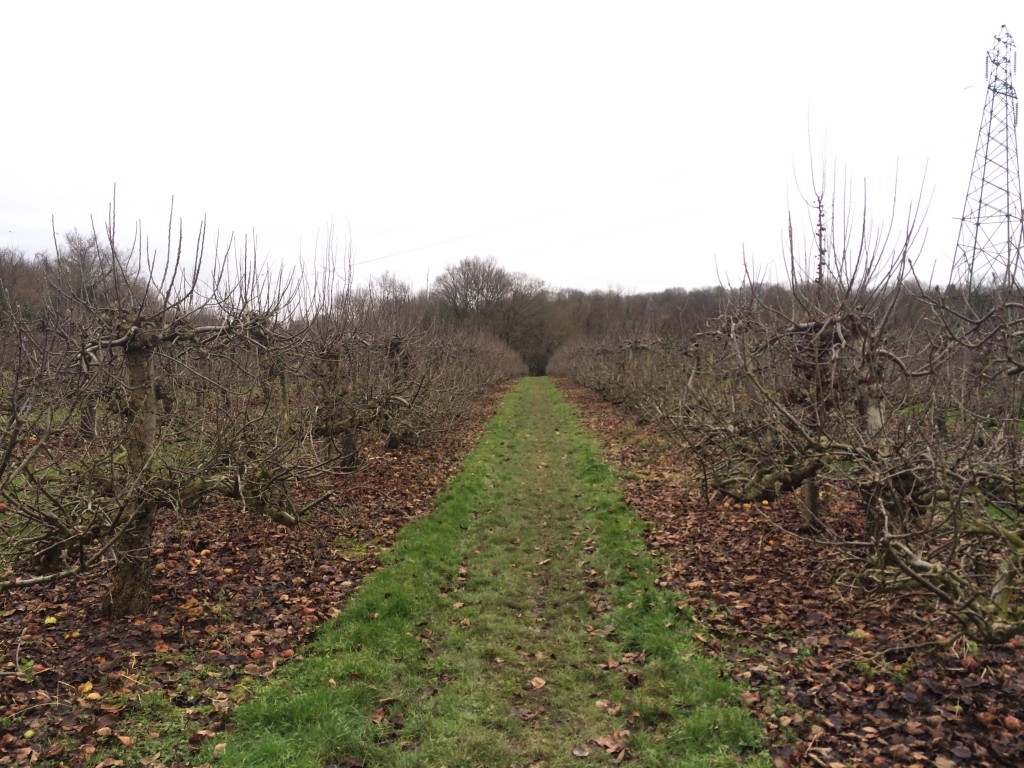Day 8 in England- A free day does not mean a day wasted!
After a very busy first week in London, Sunday, January 25th was a free day, giving everybody a chance to chose their own sightseeing adventures. Even though there were no scheduled activities, we all had a very full day! While some went off to visit Cambridge and Oxford, others stayed in and around London visiting museums, enjoying its dynamic architecture, and soaking up the city. Using a couple of photographs and a brief journal we wanted to share our day off activities with you.
I began Sunday exploring the new redevelopment around King’s Cross, a mixture of restored historic buildings, repurposed rail infrastructure, and new architecture. Of particular interest was a new apartment block with load bearing cast-iron columns, One Pancras Square, by architect David Chipperfield. Riding the Tube and Docklands Light Rail to the east end of London, I explored the redevelopment of the Royal Docks, a highlight being a ride across the River Thames on the Emirates Air Line cable car. Excellent views of the Thames Barrier, Greenwich, and Canary Wharf accompanied the windy ride, which carried me to the O2 arena (formerly the Millennium Dome) by Richard Rogers and Populous. I headed north to Queen Elizabeth Olympic Park in Stratford, where the Olympic Stadium is still being retrofitted for its use as a soccer stadium. The Aquatics Center by Zaha Hadid, the Velodrome by Hopkins Architects (pictured), and many other Olympic related structures were open to the public and great fun to explore. The (perhaps grandiosely) titled “Eiffel Tower of London,” the ArcelorMittal Orbit sculpture by Anish Kapoor and Cecil Balmond, was a perfect end to the day, with excellent views back towards historic London and forward to the contemporary landscape of the metropolis.
Kevin Adkisson
WPAMC, class of 2016
On Sunday, I returned to the Tate Britain and walked along the Thames to the National Gallery and National Portrait Gallery. Our trips to Buckingham Palace, Hampton Court and Westminster Abbey had inspired me to find two more paintings by Vermeer (total trip count: 3), Henry, Marys, Elizabeths, Annes, and medieval altarpieces. National Portrait Gallery favorites included the only painting of the Bronte sisters (thanks to someone who discovered it in a cupboard), Beatrix Potter, and souvenir felt finger-puppets. I met Emily and Rosalie for tea near Liberty’s around 3:00 before we rushed to join Rosemary, Lauren, Amy, Willie and Kevin for Evensong at Saint Bartholomew the Great, a more than 900 year-old tradition recommended by Angus Lockyer. My slightly escapist but so enjoyable adventure in English history is best represented by this Staffordshire teapot’s addition of Spanish Armada drama to afternoon tea: a welcome continuation of encountering colorful and surprising historic characters!
Hannah Boettcher
WPAMC, class of 2016
I spent my free day in Cambridge, meeting up with old high school pals and exploring the medieval city. Aside from catching up with friends over dumplings for lunch and late afternoon tea, my favorite parts of Cambridge were the prolific bicycles and Perpendicular Gothic architecture, both seen here in this image taken outside King’s College Chapel.
Katie Bonanno
WPAMC, class of 2016
On my free day, I took the train out to Oxford. Gothic Revival architecture is the subject of my final project for our English Design History class, so I figured the hallowed college town (with its true Gothic as well as revival architecture) would be a perfect place to advance my research while taking in some beautiful scenery. The sense of place at Oxford is amazing, and though my intention was to “take it easy” on my day off, since our schedule is otherwise so jammed-packed, I couldn’t resist the impulse to keep moving and to see as much as possible. Breathtaking architecture was everywhere—including the Radcliff Camera (pictured), the Examination Rooms, and almost every college building in town—and I capped my visit with a panoramic view of the town’s soaring spires from the top of Carfax Tower. Yet some of my best experiences were short visits to both the Natural History Museum (in an amazing Gothic Revival building) and the Ashmolean Museum—where I saw the lantern carried by Guy Fawkes during the Gunpowder Plot! I’d highly recommend at trip out to Oxford to anyone visiting London, for its architecture, cultural institutions, and its hip, vibrant street scenes.
Michael Emmons
PhD Program in Preservation Studies
On my day off I spent time studying in the V&A and then walked through London’s Soho to look at early store and warehouse architecture before ending at Covent Garden. I’m pulling together some of the visuals for the warehouse article I’m finally prepared to write and this section of London was one in which I had not previously spent much time. I was surprised to find B Flegg’s store-front lettering for horse furniture that survives (presumably touched up) from the nineteenth century. Occupying the ground floor is a posh shopfront for women’s clothing. I’m always fascinated to find these layers from the past and to record their parallels in other parts of the world.
J. Ritchie Garrison
Director, Winterthur Program in American Material Culture
Having attended Trinity College in Hartford, William Burges’ only non-European commission, I started my day on a search for Tower House, the house Burges designed for his own occupancy starting 1875. A wonderful Gothic Revival building, I was immediately struck by the similarities between Tower House and Trinity’s iconic Long Walk buildings. From there I walked around the Kensington-Chelsea area, working my way through a long list of remarkable nineteenth century buildings I wanted to see, such as Richardson Norman Shaw’s wonderful Old Swan House (1876).
I slowly meandered up the Thames, eventually taking a bus to Inigo Jones’ Banqueting House at Whitehall, where I was more than content to flop into a bean bag and look up at the spectacular ceiling by Peter Paul Reubens. More wandering led me to Liberty & Co. and Selfridges, among other places, and I ended my day at St. Bartholomew the Great at a wonderful evensong service.
Willie Granston
WPAMC, class of 2016
During my free day, I made my way by Underground (appropriately) to the London Transport Museum. Located in the corner of Covent Garden, I got to walk through that historical market, which was buzzing on a Sunday. The Museum was also packed, mostly with families because of all the kid-friendly exhibits and the several transport vehicles (real and readapted) they could play on. I walked through their main chronological display of the history of getting around in London and the evolution of the mass transport design, development, and context. I was hoping for posters on every wall because of my great interest in graphic design—especially the work of E. McKnight Kauffer, an American who designed extensively for London Transport in the 1920s and 1930s. There were not as many posters as I hoped, but the Museum satisfied my graphics need by including many multi-drawer display cases of Transport ephemera! Each drawer had a theme label and I noticed kids and adults frequently pulling out the sturdy drawers to reveal the surprises inside. What a great way to solve the challenge of displaying this medium.
Lauren McDaniel
PhD Program in American Civilization
Early Morning on Belgrave Rd.
This was my first trip to London, there was no way I was going to sleep in. My day began with Tridentine Mass at Brompton Oratory and ended with Argentinian food. In between I saw paintings by da Vinci, Vermeer, van Gogh, Gilbert Stuart, and Thomas Gainsborough at the National Gallery and the National Portrait Gallery. I learned about the Great War at the Imperial War Museum, climbed 311 steps to the top of the Monument to the Great Fire of London, and witnessed the magnificence of St. Pancras Station. Why sleep in when there is so much to explore?
Matthew Skic
WPAMC, class of 2016
My day off began with a bus ride to the National Gallery, where I explored several vast galleries and visited some Dutch genre paintings. I continued on towards Piccadilly Circus, where I perused Hatchards, a bookstore established in 1797, and then took a walk around the exterior of the Royal Academy of Arts. After browsing some nearby used bookstores, I met up with Rosalie and Hannah to drink tea and attend a choral Evensong at St. Bartholomew the Great, a twelfth century church. The photo above is from my last adventure of the evening, to an address near the church which used to be a paper and ink factory that has recently caught my interest. An exciting end to a wonderful and busy day, I found out that the street continues to house companies dedicated to design and artistic production.
Emily Pazar
WPAMC, class of 2016
Being a mountain person, I knew I needed to get a bit dirty on our day off. I decided to take a walk in the country, from the Borough Green train station to Ightham Mote (http://www.nationaltrust.org.uk/ightham-mote/). It was exactly what I was looking for in the English country, and I now have a new appreciated for the power of English mud. The walk included suburban trails, grazing fields, and an accidental trespass onto the land of the princess of Saudi Arabia. Despite getting fairly lost, my walk in the country was a refreshing and exhilarating way to spend a free day in England.
Kiersten Mounce
PhD Program in Art History
To start my day off, I returned to one of my favorite places in London, the Victoria and Albert Museum. It was my fifth visit to the V&A in less than one month, and I still feel as though I saw only a fraction of the museum! The wide range of displays and activities in the Theatre and Performance Gallery and in the British Galleries, including trying on a hoop skirt (as pictured above), were enough to keep me occupied for a few hours. I also stopped in at the Disobedient Objects exhibit and the Rapid Response Collecting Gallery, both fascinating examples of the Museum’s current focus and innovative collecting practices. After this visit, I spent some time with the familiar faces found in the National Portrait Gallery, and subsequently met up with Emily and Hannah for some tea. Following this respite, we window shopped along Carnaby Street and in Liberty of London, and after a few transportation snafus, joined a group of fellow students at the Evensong service of St. Bartholomew the Great. All in all, a highly enjoyable day!
Rosalie Hooper
WPAMC, class of 2016
The highlight of my day off was walking down Regent’s Street from Oxford Circus, past All Souls Church, to Regent’s Park. For this route, eighteenth-century architect John Nash devised an ingenious plan to unify the notoriously disorganized streets of London with trompe l’oeil architectural vistas and repeated Neoclassical facades. The crescent at the foot of Regent’s Park was an excellent primer for the city plans of John Wood the Elder and John Wood the Younger we would see in Bath.
Along the way, I happened across Duchess Street, where Thomas Hope’s great museum of Regency Neoclassical taste once stood. Knowing it was destroyed long ago, I was pleasantly surprised to find an Art Deco interpretation of Egyptian design on Duchess Street in this facade designed by Arthur Bolton circa 1924. While we can’t visit Hope’s Egyptian interiors, their spirit survives on this eternally chic side street.
Amy Griffin
WPAMC, class of 2016
Sunday, January 25, 2015, was a beautiful, spring-like day in London. I spent the day in Kensington Garden and Hyde Park. Families and friends were walking pets, scootering, riding ponies, feeding waterfowl, blowing bubbles, arguing. It was wonderful to be outside. But I spent many hours inside, too. I toured Kensington Palace. I’d been intrigued by the interpretive techniques of the Historic Royal Palaces when we visited Hampton Court, and wanted to see more.
But another goal was visiting the nearby Serpentine Gallery. The curator had been profiled in The New Yorker. I was curious to see the installation and it was free admission! German sculptor Reiner Ruthenbeck’s works were on display. His “Overturned Furniture” was chaotic at first glance, but orderly at second. It was both similar and dissimilar to the carefully curated spaces that we’d seen. The enjoyable part of looking at contemporary art, for me, is how it helps me look at the rest of the world more attentively. After viewing his installation of a gray, gritty, conical ash heap, I was very happy to see fresh-looking, dark sienna-colored earth being spread in a landscaping project on the way to the Speaker’s Corner. For more images of Ruthenbeck’s work, see http://www.reiner-ruthenbeck.de/
Rosemary Krill
Senior Lecturer, Academic Programs, Winterthur Museum



















Leave a Reply